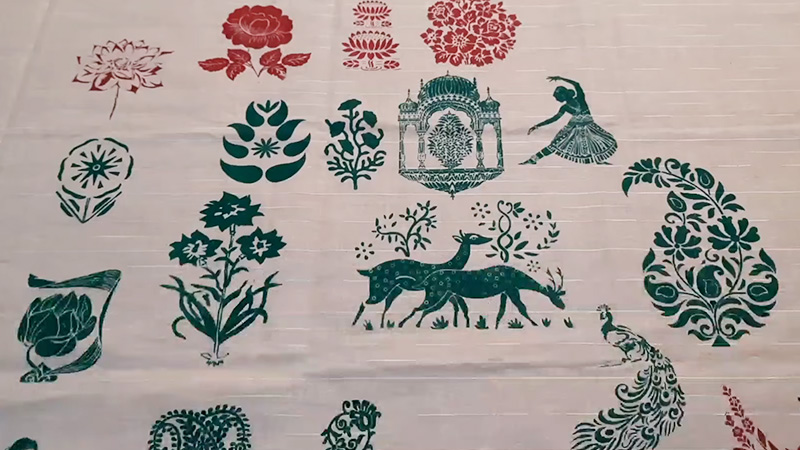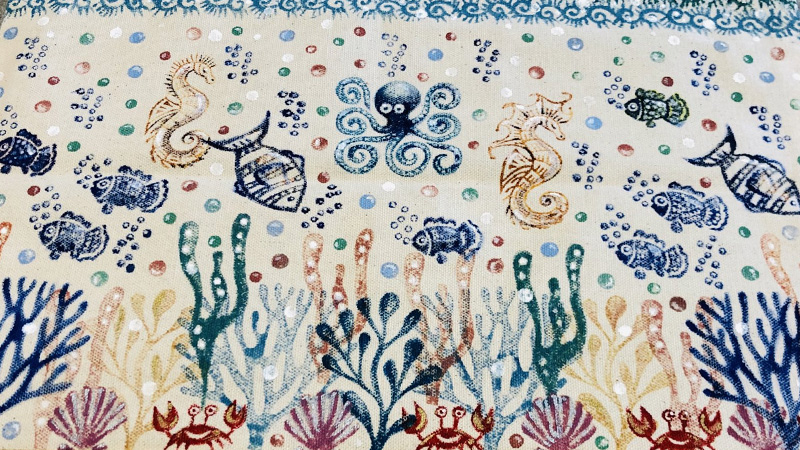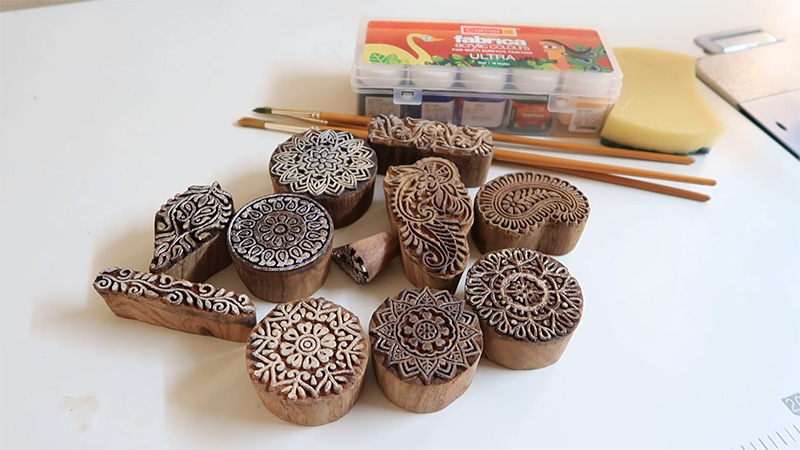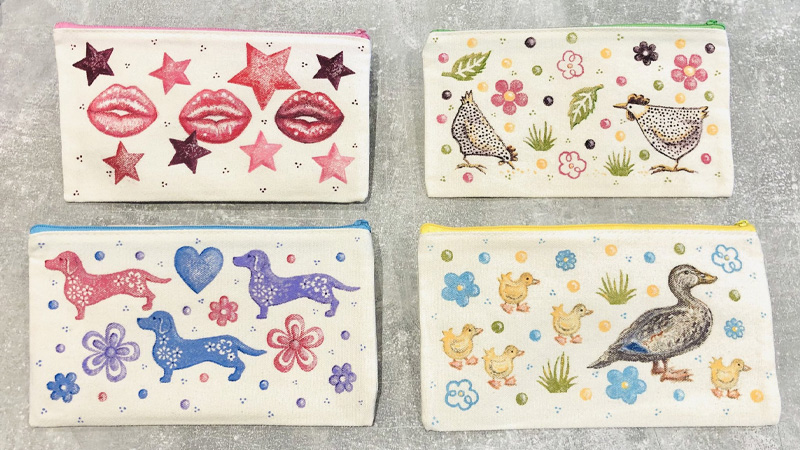Block printing onto fabric is a captivating and age-old art form that allows individuals to transform plain textiles into personalized works of art.
This ancient craft, with its roots tracing back to various cultures across the globe, provides a unique way to add intricate designs, patterns, and colors to fabrics for a wide range of creative projects.
Whether you are a seasoned artist or a beginner, block printing on fabric offers a fulfilling and accessible means of self-expression.
This introductory guide will take you through the fundamental steps and materials needed to embark on your block printing journey. From design creation and block carving to ink preparation and the actual printing process, we will delve into the intricacies of this craft.
Discover the joy of turning a simple piece of fabric into a canvas for your creativity, and learn how to block print onto a fabric that can be used for clothing, home décor, and more.

What Is The Block Printing Technique?
Block printing is a traditional and versatile technique used for creating intricate patterns and designs on fabric, paper, and other surfaces. It involves the use of a wooden block, often carved with a specific design or pattern, and ink or dye.
The process begins with the artist or craftsman carving the desired design onto the wooden block, creating a raised, relief surface. Then, the block is coated with ink or dye, and the block is pressed firmly onto the chosen material, transferring the design onto it.
This repetitive stamping process can produce beautiful, repetitive patterns, and it allows for a wide range of colors and designs to be applied to textiles, wallpapers, and even artwork.
Block printing is a labor-intensive and meticulous craft, often requiring great skill and precision, and it has a rich history in various cultures around the world, including India, China, and Europe, where it has been used to create stunning textiles and decorative items for centuries.
How To Block Print Onto Fabric?

Block printing onto fabric is a creative and rewarding craft that allows you to customize textiles with your own designs. Here are some simple methods to guide you through the process:
Design Creation
Start by creating or selecting a design for your block print. You can draw it on paper or use digital design software to create a pattern. Keep in mind that block prints often feature repetitive motifs.
Block Carving
Transfer your design onto a wooden or linoleum block. Then, using carving tools, carefully remove the material around the design, leaving a raised relief of your pattern on the block’s surface. Ensure your carving is precise, as this will determine the final print’s quality.
Ink Preparation
Choose fabric-friendly block printing ink or fabric paint. Mix and spread the ink evenly on a flat surface, such as a glass or acrylic sheet, using a brayer (a roller). The ink should have a consistent and thin layer for uniform printing.
Testing
Before you start printing on your fabric, do a test print on a scrap piece to ensure your block transfers the design as intended. Adjust the ink consistency, pressure, and alignment if necessary.
Fabric Preparation
Lay your fabric on a flat, clean surface, and make sure it’s free of wrinkles. You can use plain cotton, silk, or any other natural fabric for block printing. Iron the fabric to remove any creases.
Printing
Apply ink evenly to your carved block using the brayer. Then, carefully position the block on the fabric where you want to print and press it down evenly. Apply uniform pressure across the block to ensure a consistent print. Repeat the process, aligning the block precisely for a repeated pattern.
Drying and Fixing
Allow the printed fabric to air dry completely, or follow the instructions provided by the ink or fabric paint manufacturer. Once dry, use an iron to set the print.
Cover the fabric with a cloth or parchment paper and iron it on the appropriate heat setting. This heat-setting process helps the ink or paint bond to the fabric and resist washing out.
By following these steps, you can successfully create beautiful block-printed designs on fabric. Experiment with different colors, patterns, and fabric types to unleash your creativity and personalize your textile projects.
Basic Materials For Block Printing Fabric

Here are the basic materials needed for block printing on fabric:
Block Printing Blocks
These are the primary tools used in block printing. Blocks are typically made of wood, linoleum, or rubber. They come in various shapes and sizes, with designs carved onto their surfaces. These blocks are essential for transferring the design onto the fabric.
Block Printing Inks or Fabric Paints
Specialized block printing inks or fabric paints are formulated to adhere well to fabric fibers. They come in a variety of colors and are available in water-based or oil-based options.
Fabric paints are versatile and can be used for both hand painting and block printing techniques.
Brayer (Ink Roller)
A brayer is a roller used to spread the ink evenly on the block’s surface. It ensures that the ink is applied uniformly, creating consistent prints. Brayers come in different sizes; choosing the right size depends on the size of your block and the area you are printing.
Palette or Flat Surface
A palette or a flat, smooth surface (such as a glass or acrylic sheet) is used for spreading and mixing ink. It provides a non-absorbent surface for the ink, allowing you to work with it efficiently.
Fabric
Natural fibers such as cotton, linen, silk, or blends are ideal for block printing. The fabric should be prewashed to remove sizing and ensure that the ink adheres well.
Choose the fabric type based on the intended use of the printed material, such as clothing, home decor items, or accessories.
Carving Tools
Carving tools are used for carving designs onto the block. These tools come in various shapes and sizes, allowing artists to create intricate patterns. V-shaped gouges, U-shaped gouges, and knives are common tools used for carving blocks.
Paper and Pencil or Design Transfer Tools
You need paper and a pencil to sketch your design before transferring it onto the block. Alternatively, you can use carbon paper or tracing paper to transfer the design accurately onto the block’s surface. Design transfer tools help ensure your design is replicated faithfully on the block.
These essential materials form the foundation of block printing on fabric. By investing in quality tools and materials, artists can create impressive and durable prints on various fabric surfaces, adding a personalized touch to their projects.
Types Of Block Printing

Block printing is a versatile craft that has evolved into various techniques, each with its unique characteristics and applications. Here are the types of block printing:
Woodblock Printing
Woodblock printing is one of the oldest forms of block printing, with origins in ancient China. It involves carving a design onto a wooden block’s surface. The raised design is then inked and pressed onto fabric or paper to create prints.
Woodblock printing is known for its intricate patterns and has been used historically for textiles, art prints, and decorative items.
Linocut Printing
Linocut printing is a more recent development, using linoleum blocks instead of wood. Linoleum is easier to carve than wood and allows for sharper, more detailed designs.
This technique is popular among contemporary artists for creating bold and graphic prints on various surfaces, including fabric and paper.
Rubber Stamp Printing
Rubber stamp printing involves using pre-made rubber stamps with designs already carved into them. This method is accessible and user-friendly, making it a favorite choice for hobbyists and DIY enthusiasts.
Rubber stamps are available in a wide range of designs, making it easy to create repeatable patterns on fabric, paper, and other materials.
Copperplate Printing
Copperplate printing, also known as etching, is a form of intaglio printmaking rather than block printing. It involves etching a design onto a copperplate, inking it, and then transferring the inked design onto paper.
While not as commonly associated with fabric, it can be used for fine art prints on specialty fabrics.
Screen Printing (Screen Block Printing)
Screen printing is a versatile and widely used method where a design is transferred onto a fabric through a fine mesh screen. The screen is coated with a stencil of the desired design, and ink is pushed through the mesh onto the fabric using a squeegee.
Screen printing is well-suited for producing detailed, multicolored prints on textiles, including clothing and posters.
Mughal Block Printing (Hand Block Printing)
Originating in India, Mughal block printing, also known as hand block printing, is a labor-intensive process where skilled artisans carve intricate designs onto wooden blocks.
These blocks are used to print intricate patterns on textiles like sarees and quilts. Each color requires a separate block, and the process often involves several craftsmen working collaboratively.
Batik Printing
Batik is a wax-resist dyeing technique that incorporates block printing. Hot wax is applied to fabric in specific patterns using a stamp or a tjanting (a tool with a spout).
Afterward, the fabric is dyed, and the waxed areas resist the dye, creating a beautiful, intricate design with vibrant colors. Batik is particularly popular in Indonesia and other Southeast Asian countries.
Each type of block printing offers its own unique aesthetic and creative possibilities, making them suitable for a wide range of artistic and practical applications.
Artists and crafters can choose the method that best suits their desired outcomes and skill levels.
FAQs
How do I choose the right fabric for block printing?
Choose natural fabrics like cotton, linen, or silk for block printing. These materials readily absorb ink and produce vibrant prints. Pre-wash the fabric to remove sizing and ensure better ink adhesion.
Can I use regular paint for block printing on fabric?
While some acrylic paints can be used for fabric, it’s best to opt for specialized fabric paints or block printing inks. They are formulated to bond well with fabric fibers, resulting in durable and wash-resistant prints.
Do I need any special skills to carve my own printing block?
No, you don’t need to be an expert carver. Start with simple designs and practice carving on scrap wood or linoleum. As you gain confidence, you can tackle more intricate patterns.
How can I ensure my block prints are consistent and even?
Achieving even prints requires consistent ink application and pressure while printing. Use a brayer to apply ink evenly, and press down on the block evenly to avoid smudging or uneven prints.
Is block printing safe for the environment?
Block printing is generally eco-friendly as it often uses water-based inks and natural fabrics. However, be mindful of proper ink disposal and clean-up to minimize environmental impact. Consider using eco-friendly inks for a more sustainable approach.
Conclusion
Block printing onto fabric is a rewarding and versatile art form that empowers individuals to infuse their personal touch into textiles. Throughout this guide, we have explored the essential steps and materials required to master this craft.
From the initial design conception to carving intricate patterns onto blocks and transferring them onto fabric, block printing allows for endless possibilities in creating unique and eye-catching designs.
As you embark on your block printing journey, remember that practice and experimentation are key to achieving stunning results.
Whether you aim to adorn your wardrobe with handcrafted garments or add distinctive elements to your home décor, block printing offers a creative outlet that is both enjoyable and accessible.
So, pick up your carving tools, select your favorite colors, and let your imagination run wild as you explore the rich and vibrant world of block printing on fabric.
Leave a Reply